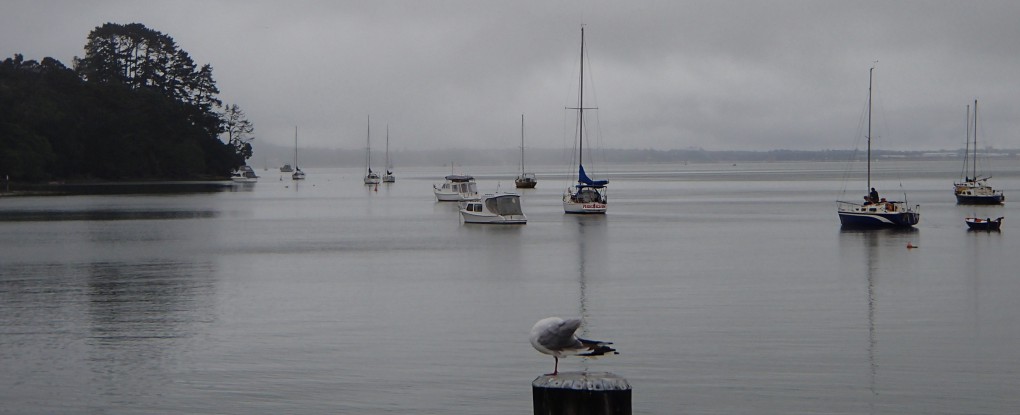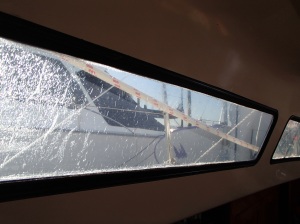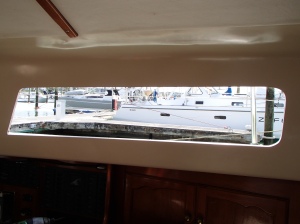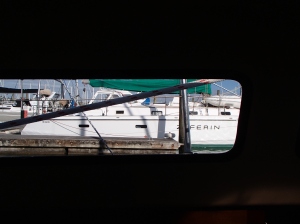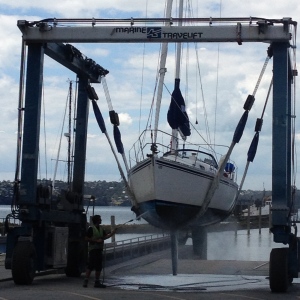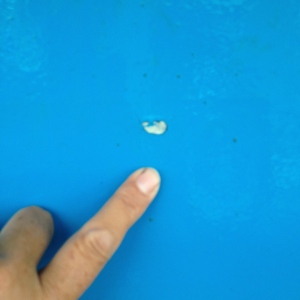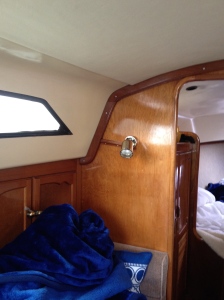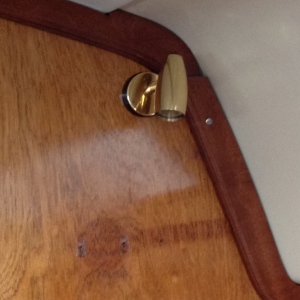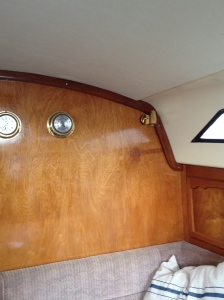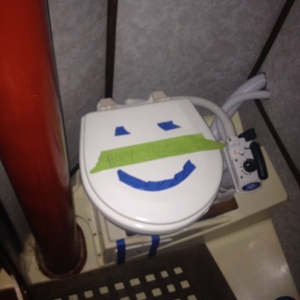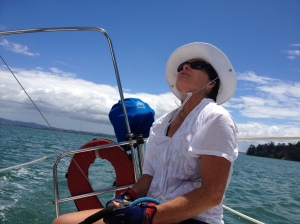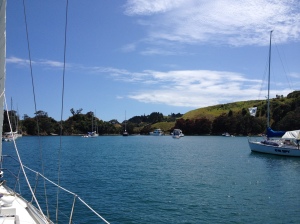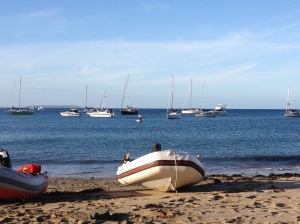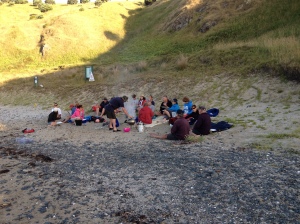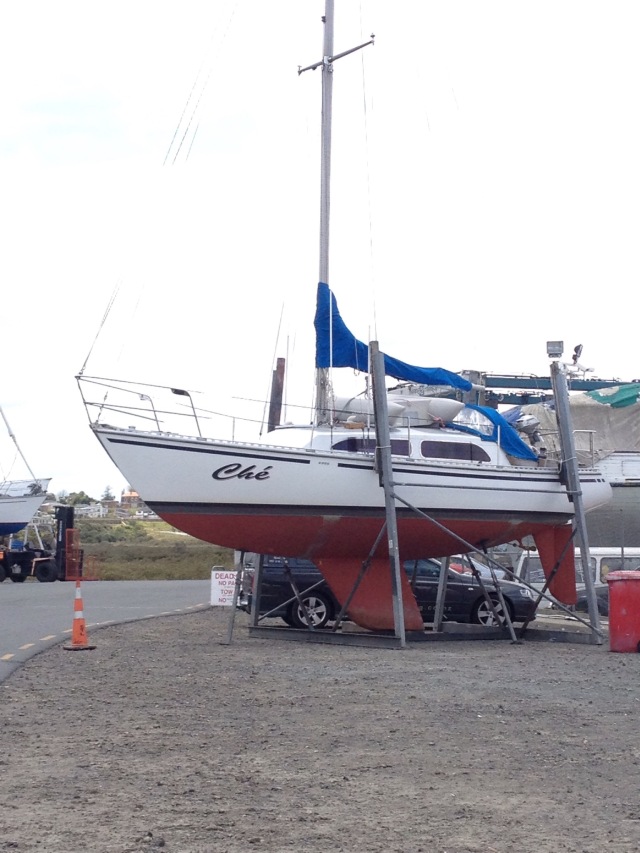Living on a boat has been touted as a cheap solution to the Auckland property crisis and there is a trend towards minimal living and small spaces; boats combine both of these. Perhaps the ideal solution for some, not much has been written about the reality of life on board.
I live by myself on a 10.2 metre yacht, people live on smaller vessels and many on larger. Launches have more volume, which means more living space but, for me as a sailor, that was never an option. I’m fortunate because I own a house and already had the boat when I chose to move on board. So what’s it really like?
The cabin is in the bow (front of the boat), your king size bed, if you put a pillow in the centre at the foot of the bed that is the width of the end of my bed – the head can stay the same width but you are going to have to climb over the end to get into it because that is the total width of the “bedroom”. Oh, and in most boats unless you can get a mattress made to fit then you are sleeping on squabs, which are normally about 100mm thick and really not at all comfortable. Changing the sheets is a pain, you can’t walk around the bed and tuck things in, I custom made bedding to fit (but I had to borrow a house friend’s dining table so that I had room to sew).
There’s about a metre of space back from the bed, just enough room for some drawers and a hanging locker (wardrobe) on one side and the head – toilet and a small hand basin on the other. I’m lucky to have a shower too but it’s a pain to use as everything gets wet and has to be wiped down, I guess the room is slightly bigger than a large house shower cubicle. The toilet is connected to a 60 litre holding tank, a reasonable size for a boat, but it fills up quickly. To empty it I can head out to sea, but the regulations mean that I have to be two kilometres off shore before I can empty it into the ocean. The other option is “pumping” it out – literally connecting to a pump and having the tank contents sucked out and taken away for disposal.
Alternatively I can head for the ablutions block, so every time nature calls I walk the 300 metres to land and back again, not so bad in the summer but early on a frosty winter morning, in the middle of the night when you’ve eaten something bad or when it’s pouring with rain and windy not so much fun. I use the shower on land too as it’s much easier but it does cost a dollar for six minutes and often at peak times there is a queue and again not that pleasant when it’s cold and wet.
I imagine you sitting on your three seater couch reading this! Have you got two couches and a coffee table? Put the coffee table between the couches and then push them together – that’s about the total size of my saloon (lounge and dining area). There is a little storage behind the settees but not much. It’s probably a good thing that there is space to sit only six, at a squeeze, around the table when it’s put up for dinner because cooking for more would be a mission in my small galley. I’ve got a gas stove with two elements and an oven big enough to roast a chicken but only if you don’t want roast veges too. When you take away the sink space my bench is the size of a tray, not much room for food prep, but that’s ok because there’s not much in the way of food storage either or room for many kitchen gadgets. You learn to be a clever cook on a boat, experimenting with ready made spice mixes, sauces and finding good easy deserts but don’t expect ice cream with that as I don’t have a freezer. I’ve got a small fridge under the chart table that keeps milk, cheese, meat, a few veges and the wine cool but that is it. After a few weeks of living on board I decided that I needed an electric toaster but that is my only kitchen appliance – there’s not enough space for anything else.
There’s one more space and that’s known as the aft quarter berth or spare bed or storage space – it’s about three quarters the width of a single bed and long enough for most people to sleep in. If I have more than one person staying then I drop the table and make a double bed but it’s not that comfortable for anyone.
That’s all that’s inside. I invested in a “tent” to enclose the cockpit, which is brilliant in the winter. It’s like a conservatory, allowing me to keep the inside of the boat dry when I come in while it’s raining and giving me somewhere to put wet things. In the summer it gives me somewhere to sit outside in the shade, this coming summer I’ll probably sleep out in the cockpit at least some of the hotter nights. Even with a fan there are nights when it’s unbearably hot and there’s nowhere to go to get cool.
The summer heat is only one of the sleeping challenges. In the winter when it’s stormy the boats move, the lines creak, the wind might keep you awake but after a while you get used to your own boat; it’s the rest of the marina that will keep you awake. Wind in rigging is really loud and if you’ve got a boat with a wind vane next door then forget sleeping.
We take a lot for granted when we live in houses, it takes a lot more thought and organisation living on a boat. Take electricity for example, most boats are powered by 12 or 24 volt DC batteries that run lights, fridges, stereos, start the engine and through an inverter can run the TV and power some smaller 240V appliances (so you can charge your phone). The batteries have to be charged, which means using solar panels, running your engine or being plugged in to shore power, which is what I do. Most marinas require you to produce a current electrical warrant of fitness before you can use the supplied “shore” power. At the very least this means engaging an electrical inspector to check the boat has the correct circuitry in place; if not, it will cost at least $1000 to get a very basic installation. The 12V switchboard and inverter on my boat needed upgrading to pass an electrical warrant of fitness. So, at the same time, I had installed a simple 240V system that gives me a power point for electrical appliances. The day I bought the toaster my life changed – no more watching bread burn round the edges.
I’m fortunate that when I bought the boat she had a gas califont that gives me hot water in the head and in the galley but you can just about guarantee that the gas will run out about 20 minutes before the roast is cooked, in the winter, when it’s raining and you’ve forgotten to refill the spare bottle….oops!
Living in a house we take for granted tv, internet, washing and drying clothes, which are all part of the challenge that live aboards face. For clothes there is the Laundromat, tv you can attach an aerial somewhere and internet… well unless you live somewhere that has cables then that will cost – mobile data is expensive! Three hundred metres is the measure of my life – the ablutions, the laundry, the car park, dry land, everything I do is that far to get to. It may not sound like much but it takes time and has to be considered no matter what you do, add 10 minutes and don’t think of ten thousand steps as a challenge.
There is the impression that living on a boat is cheap. Maybe there are financial benefits to not renting in Auckland but I’m not convinced that it really is that much cheaper. There’s the cost of buying the boat, insurance and setting it up so that it is suitable to live on and the ongoing maintenance costs to ensure that it is seaworthy even if it never leaves the dock.
A berth can be purchased for anything from $10,000 to $100,000 or more and there are ongoing operating expenses. Costs depend on the size and location of the berth. When renting a marina berth you can expect to cover at least the owner’s costs. In Auckland many marinas charge an additional live aboard fee.
It costs me about $700 a month to cover these fees, I could rent a room in a house nearby for about the same.
There are the usual household utilities to pay, yes my power bill is small but I have a tiny space to heat, don’t have a tv, dishwasher, microwave, electric blanket, washing machine or coffee maker. My stereo is a 12 volt car stereo, I cook with gas and pay a dollar a day for a shower.
If you do decide to take up the challenge of life on board and you’re not already a boatie I encourage you to get some experience before committing. Take some boating courses and don’t let it become another one of the boats that never start the engines.
For all of that would I swap where I live, hell no! In the two years I’ve been on the boat I’ve made a lot of friends and met even more interesting, inspiring people. I love the fact that it takes me ages to go anywhere (especially in the summer) because there’s always someone to say hi to. I enjoy waiting for my washing so I can browse the “laundry book library’’. It’s liberating that I don’t need to own a lot of stuff nor have a lot of space to put it. I have learnt a lot about myself but most of all I love being on the water and whenever possible I’m ready to throw the lines off and go sailing.
